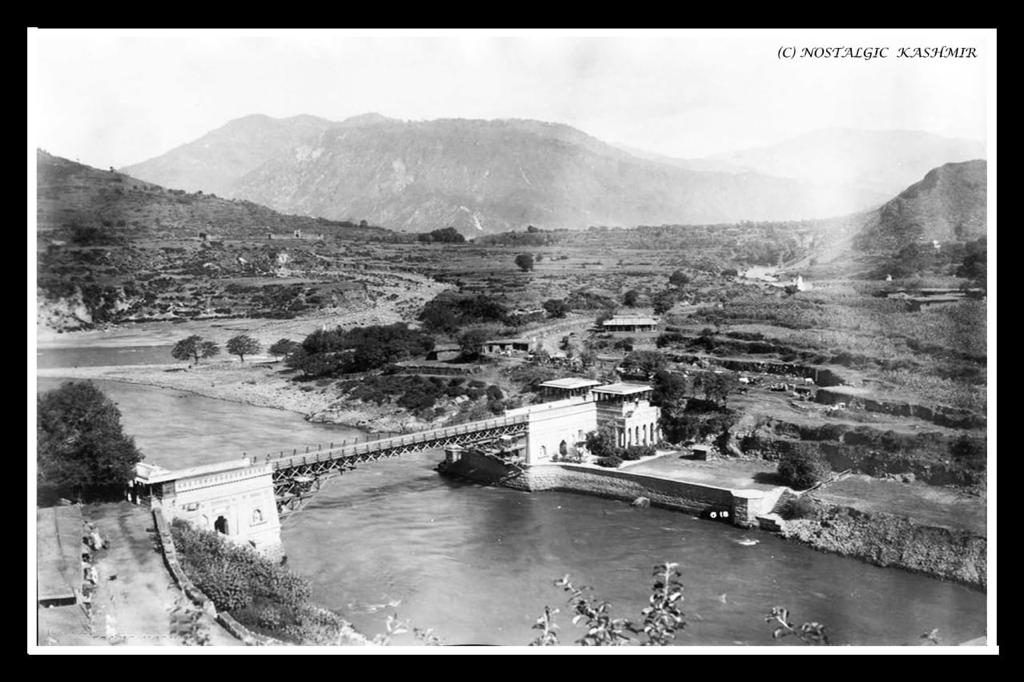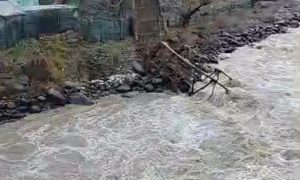Srinagar city was known as the ‘Venice of the East’ for the various waterways that ran through its heart. In fact, water transport was the main mode of movement until yesteryears.
However, as people from outside kept coming in, either as traders or as soldiers and the needs of locals started expanding beyond waterways and tributaries, the road transport kept on developing. With every new regime new roads were built and older ones were either demolished or improved upon.
While Jhelum has always been a symbol of the local populace, the bridges of Kashmir very conveniently become representatives of a larger political dynamics that has kept the Kashmiri socio-political discourse abuzz over centuries.
Apart from having a common larger historical narrative, the bridges have histories of their own as well, some being used for tax collections by various administrations, others serving as stakes for punishments on the perpetuators of trivial crimes, and in recent past many of them having stood witness to gruesome massacres of innocent Kashmiris. As such knowing and preserving their history becomes pertinent upon us.
Baron Hugel wrote in 1835, “these bridges were already found laid across the rivers by the Mohammadens which give antiquity of last 500 year”. According to Baron major restorations were done during the rule of Rani Kotadevi, whose rule, according to Ayin Akbari, lasted until 1364 C.E.
Auriel Stein however is of the other opinion, he believes that it was Zain-ul-Abideen who constructed the first permanent bridge over river Jhelum which is named after him as Zaina Kadal. Stein finds it surprising that none of the bridges can be traced back beyond the time of Zain-ul-Abideen.
Renowned Kashmiri historian M.D Sufi draws the conclusion that the stone architecture, in which the engineers of the Hindu period were very proficient, did not permit construction of bridges with sufficient span.
The Muslim architects mainly worked in wood and thus the impediment was overcome by these master crafters.
They were proficient in the peculiar cantilever construction which was incorporated in almost all the bridges of Srinagar. Brigadier General Sir Percy Sykes in his paper, ‘The heart of Asia and roof of the world’ read before the Royal studies of arts concluded that the system of cantilever bridges was actually invented in the heart of Asia.
The British settlement officer and historian Sir Walter Lawrence says “the bridges are cheap, effective, picturesque and, in their construction, ingenious. The secret of their stability may perhaps be attributed to the skeleton piers, offering little or no resistance to the large volume of water brought down at flood time.”
Below I go on to mention brief histories of the 7 bridges over Jhelum, the bridges like Kashmiris have stood the test of time and fate and shall hopefully, in future as well, keep on defying the odds of all political, social and existential questions along with the resilient Kashmiris who ply over them.
Zero (Zor Kadal/Zar Kadal): The zeroth bridge was constructed in 1950s. It is said to have been named so because traditionally the Amira Kadal bridge was regarded as the first bridge on the Jhelum as it entered Srinagar and the Zero bridge preceded this first bridge.
Another lesser known anecdote behind its etymology is that the the Contractor of Zero Bridge, Sona Ullah Shora Sahab of Shore Garee Mahalla Nawab Bazar was hard of hearing (“zorr” in Kashmiri) and ironically even the section officer and assistant engineer were hard of hearing and thus the attribution of Zero bridge (Zearri bridge).
This bridge closed to traffic in the 70s owing to weakened wooden structure.
First bridge(Amira Kadal/Amiran Kadal/Omra/Womra): This bridge was built by Afghan governor Amir Khan Sher Jawan in 1774-1777 with the help of local boatmen (Hanjis). With help of this strong and study class of people he also built Sher Garhi Palace on it.
It was a 5 pier wooden cantilever construction 150 yards long and 6 yards wide. The bridge was fully damaged in devastating floods of 1893 but was soon rebuilt.
This bridge been a witness to everything from Afghan tax collectors flogging the locals to collect zar-i-habubat to Dogras extracting taxes from artisans and peasants, to the more recent events after 1947.

Photograph of Amirakadal bridge in 1865 taken by Samuel Bourne.

Second bridge (Habb’e Kadal/Habba Kadal): The bridge is said to have been built by Sultan Habib Shah who reigned from 1557-1561 C.E. Some historians attribute its construction to Yusuf Shah Chak (1579-86) and is said to have been named after Habba Khatoon.
This bridge too had to be rebuilt after the deluge of 1893. A new bridge was constructed by Maharaja Partap Singh in 1898 which was 300 feet long and 32 feet wide 3 pier Wooden Cantilever structure.
Habba Kadal holds great political importance as it provided one of the chief platforms to Kashmiris against the Dogra rule. It was a regular site of rallies and protests organised by the local leaders against the Maharaja.

Habba Kadal, photo by Marion Doughty in 1902. On the left of Photographs just down stream of the bridge Purusyar Temple can be seen.
Third bridge (Fateh Kadal): This Bridge was originally constructed by Sultan Fateh Shah in 1520 C.E. It was an 88 yard long 3 Pier wooden Cantilever structure.
This Bridge was repaired from time to time till Maharaja Partap Singh dismantled it and reconstructed a new 300 feet long and 32 feett wide bridge at the same spot in 1902 AD.

From ‘The Romantic East: Burma, Assam, & Kashmir’ by Walter Del Mar (1906).
Fourth bridge (Zaeine Kadal/Zaina Kadal): As already mention this 92 yard bridge was constructed by Zain-ul-Abidin (1420-74) in 1427 C.E. in 6 years. It was a typical wooden bridge of cantilever design and was aimed at being used as a market place as well.
Quoting Jonaraja, Zutshi a renowned historian says “the most important permanent bridge built on Jhelum was the Zaina Kadal bridge supervised by the city-perfect (probably equivalent of an architect of modern times) Kanch Damara.”
This bridge was dismantled and reconstructed by Partap Singh in 1897 and again a new bridge was constructed by Hari Singh in 1926, which was repaired in 1953-54 by the NC government.

Zaina Kadal from the book Irene Petrie: Missionary to Kashmir (1903). Photograph by Geoffroy Millias.
Fifth bridge (Aael Kadal/Aali Kadal/Ali Kadal): Built by brother of Zain-ul-Abidin, Sultan Ali Shah (1413-19) in 1415. Its is said to be named after Zain-ul-Abidin’s son.
The mosque of Roengton, also called Rinchan Shah Masjid is located to the north of the bridge. Pratap Singh got it refurbished later G M Sadiq, the then chief minister, got it repaired in 1964.

Aael Kadal By Francis Frith (1875).
Sixth bridge (Nawa Kadal/Naw Kadal/New Bridge/Boat bridge): Named after one Nur Din Khan Bamzai in 1666 C.E. it was rebuilt in 1953 by Sheikh Abdullah, and completed by Bakshi. But in 1981, the bridge was burnt down and was destroyed, but was later built by Farooq Abdullah’s government.

Nawa Kadal as viewed from second bridge (1875).
Seventh bridge (Safa Kadal/Saifa Kadal/Saf Kadal/Safr Kadal): Clean Bridge. Or bridge of departure. Built by Saif-ud-Din (Suha Bhatta), Chief Wazir of Sultan Sikandar and Ali Shah. Some historians attribute the building to Saif Khan during the reign of Aurangzeb. It used to be 60 yards long. Pratap Singh renovated the bridge in 1901.

Safa Kadal from ‘Our summer in the vale of Kashmir’ (1915) by Frederick Ward Denys.
Some other notable mentions (as compiled in Showkat Rashied Wani’s Nostalgic Kashmir calendar):
Khanabal Bridge – 1910: This Bridge was constructed during the reign of Maharaja Partap Singh in 1898. This wooden bridge was of 3 Pier Cantilever Construction, 95 yards long and 6 yards wide.

Khannabal Bridge.
Bijbehara Bridge – 1909: This bridge was originally constructed on the instructions of Dara Shuko in 1631 AD & was 100 yards long & 6 yards wide. Sikh Governor Col. Mian Singh in 1835 repaired the bridge.
Maharaja Ranbir singh got the Bridge reconstructed in 1872. It is 3 pier Cantilever Construction 100 yards long and 17 feet wide.
Photograph taken by W.D.Lambert in 1909.

Bijbehara Bridge.
Sumbal Kadal – 1910: This wooden 5 Pier Bridge at Sumbal down stream of Shadipora is of Cantilever Design. It was got constructed by Maharaja Partap Singh in 1903. the bridge is still standing in a dilapidated condition.

Sopore Kadal – 1866: This wooden bridge of Cantilever Design 138 yards long, 5 yards wide 5 Pier Bridge was constructed by Governor Atta Mohd Khan in 1811 AD.

Sopore Bridge.
Baramulla Kadal – 1889: The bridge was constructed by Governor Atta Mohd Khan (1808-1813) in 1810. It was a 6 Pier, cantilever type wooden bridge 142 yards long & 5 yards wide.
In the photograph taken by John Edward Sache in 1889 Doonga Taxi Boats can be seen moored on the Ghat to ferry customers from Khadnyar to Khanabal on the Veth. Old town of Baramulla can be seen in the background.

Baramulla Bridge.
Domel Bridge – 1889: This Suspension Bridge at Domel, 111 miles from Srinagar was constructed on Jhelum Valley Road by Maharaja Ranbir Singh in 1880. In this Bridge complex the Custom House was functional.
At Domel, Veth (Jhelum) is met by its Tributary the Kishen Ganga (Neelam) river.
Photograph taken by John Edward Sache in 1889.

Domel Bridge.
Kohala Bridge – 1880: Kohala is the last bridge on River Jhelum (Veth) in Kashmir. This bridge joined the Royal Territory of Kashmir State with the British Indian Territory of Punjab.
This Bridge was built in 1870 and was 132 Miles from Srinagar. This bridge was washed away in floods of 1893. Thereafter a new Girder Bridge was constructed in 1895.

Kohala Bridge.
References:
Being a history of Kashmir by G.M.D Sufi.
The valley of Kashmir by Walter Lawrence.
Kashmir vocabulary by Dr. Elmslie.
Showkat Rashied Wani’s personal collection of photos and historical pieces.
Wikipedia.








